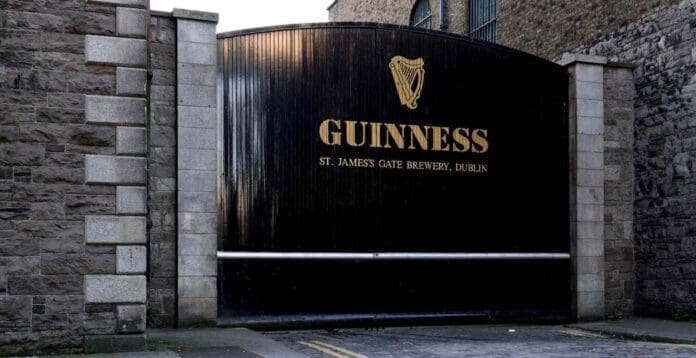Ireland is such a great place to visit, it is hard to know where to start. In this post we list the Top Tourist Attractions in Ireland that you should not miss.
Boyne Valley Ireland
20 minutes from Dublin and an hour from Belfast, the Boyne Valley is a really accessible place for a day trip and is full of historical and cultural gems such as Newgrange.
The Boyne Valley, the Birthplace of Ireland’s Ancient East, is a place steeped in history. Combined with its lush green landscape and magnificent waterways, fantastic food and drink, outdoor adventures and cultural gems, this wealth of heritage makes it a really special destination. Encompassing Co Meath and South Co Louth, the Boyne Valley is a unique holiday destination with an abundance of things to do and lots of fun family activities for the best holiday you could imagine.
Carrick-a-Rede Rope Bridge
The Carrick-a-Rede Rope Bridge is a rope bridge near Ballintoy in County Antrim, Northern Ireland. The bridge links the mainland to the tiny island of Carrickarede. It spans 20 metres (66 ft) and is 30 metres (98 ft) above the rocks below. The bridge is mainly a tourist attraction and is owned and maintained by the National Trust. In 2018, the bridge had 485,736 visitors. The bridge is open all year round (subject to weather) and people may cross it for a fee.
It is thought salmon fishermen have been building bridges to the island for over 350 years. It has taken many forms over the years. In the 1970s it had only one handrail and large gaps between the slats. A new bridge, tested up to ten tonnes, was built with the help of local climbers and abseilers in 2000. Another was built in 2004 and offered visitors and fishermen alike a much safer passage to the island. The current wire rope and Douglas fir bridge was made by Heyn Construction in Belfast and raised early in 2008 at a cost of over £16,000. There have been many instances where visitors, unable to face the walk back across the bridge, have had to be taken off the island by boat.

Fota Wildlife Park
Fota Wildlife Park is a 100-acre wildlife park located on Fota Island, near Carrigtwohill, County Cork, Ireland. Opened in 1983, it is an independently funded, not-for-profit charity that is one of the leading tourism, wildlife and conservation attractions in Ireland.
Get up close and personal with the animals by taking a behind-the-scenes tour at Fota Wildlife Park. Perfect for families and small groups, you can feed and care for the animals, and find out all about the habitats they live in
Inchydoney Beach
Inchydoney Blue Flag Beach near Clonakilty in West Cork is a Wild Atlantic Way Discovery Point. Inchydoney Beach has often been named Ireland’s favourite beach by international tourists on TripAdvisor, most recently in 2019 and described as “glorious and unspoiled”.
The beach is popular with surfers and considered suitable for beginners. There is a surf school at the beach with board and wetsuit hire.
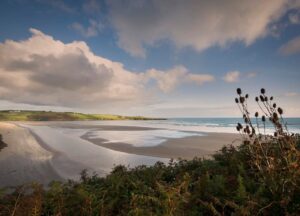
Shandon Bells & Tower Cork Ireland
Visit St. Anne’s Church – one of the oldest churches in the city built in 1722.
Climb 132 steps to see spectacular 360 degree views of the city at 36.65m/120ft.
Easy to find-just look for the ‘Goldie fish’ in the sky!!
St. Anne’s has been described as, “the most important ecclesiastical structure of any period, within the the city of Cork and its immediate environs, it is also one of the most important early 18th century churches in Ireland and one of a small number which still retains their original 18th century bells
Spike Island
Spike Island was used as an island prison on four occasions over 400 years, the first in the 1600s holding Cromwellian prisoners.
The second in the 1840s became the largest prison in the world, and there has never been a larger prison in Britain or Ireland before or since.
The third opened in 1921 and it held over 1200 Irish Republican prisoners during the Irish War of Independence.
Jerpoint Abbey
Jerpoint Abbey is a ruined Cistercian abbey, founded in the second half of the 12th century, near Thomastown, County Kilkenny, Ireland. It is located 2.5 km south west from Thomastown on the R448 regional road. There is a Visitor Centre with an exhibition. It has been declared a national monument and has been in the care of the Office of Public Works since 1880.
It was constructed in 1180, by Donchadh Ó Donnchadha Mac Giolla Phátraic, the King of Osraige. It was dedicated to the Blessed Virgin. Jerpoint is notable for its stone carvings, including one at the tomb of Felix Ua Duib Sláin, Bishop of the Diocese of Ossory. The abbey flourished until the Dissolution of the Monasteries by the English king Henry VIII.
Newgrange, County Meath
Newgrange is a prehistoric monument in County Meath in Ireland, located on a rise overlooking the River Boyne, 8 kilometres (5.0 mi) west of Drogheda. It is an exceptionally grand passage tomb built during the Neolithic Period, around 3200 BC, making it older than Stonehenge and the Egyptian pyramids. It is aligned on the winter solstice sunrise.
Newgrange is the main monument in the Brú na Bóinne complex, a World Heritage Site that also includes the passage tombs of Knowth and Dowth, as well as other henges, burial mounds and standing stones.
Kinsale County Cork
Originally a medieval fishing port, the coastal enclave of Kinsale (from the Irish, Ceann tSaile – ‘Head of the Sea’) is fabled far and wide for its beauty and rich history. Recently hailed by Conde Nast as one of Ireland’s most beautiful towns, it consistently punches above its weight.
Kinsale is just 25km from Cork City and Cork International Airport, and is the gateway to scenic ‘West Cork’ and the start/finish point of the ‘Wild Atlantic Way,’ the 2,500km coastal journey from Kinsale, Co Cork to Inishowen, Co Donegal.
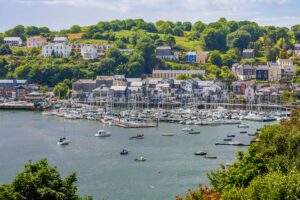
Scrabo Tower
Scrabo Tower is a 135-foot (41 m) high 19th-century lookout tower or folly that stands on Scrabo Hill near Newtownards in County Down, Northern Ireland. It provides wide views and is a landmark that can be seen from afar. It was built as a memorial to Charles Vane, 3rd Marquess of Londonderry and was originally known as the Londonderry Monument. Its architectural style is Scottish Baronial Revival.
Nowadays, the tower on Scrabo Hill is usually just called Scrabo Tower and is visited for its views and surroundings. However, its original name was Londonderry Monument or Memorial. That name referred to the Marquesses of Londonderry and only indirectly to the town or county of that name, which is 87 miles (140 km) away. The marquesses owned much ground around the hill. The hill and tower rise over the town of Newtownards, 10 miles (16 km) east of Belfast. As the tower dominates the town, it is often used as an emblem for Newtownards. The tower is built on the site of a prehistoric hill fort.
Gaint’s Causeway Antrim
The Giant’s Causeway is an area of about 40,000 interlocking basalt columns, the result of an ancient volcanic fissure eruption. It is located in County Antrim on the north coast of Northern Ireland, about three miles (5 km) northeast of the town of Bushmills.
It was declared a World Heritage Site by UNESCO in 1986 and a national nature reserve in 1987 by the Department of the Environment for Northern Ireland. In a 2005 poll of Radio Times readers, the Giant’s Causeway was named the fourth greatest natural wonder in the United Kingdom. The tops of the columns form stepping stones that lead from the cliff foot and disappear under the sea. Most of the columns are hexagonal, although there are also some with four, five, seven or eight sides. The tallest are about 12 metres (39 ft) high, and the solidified lava in the cliffs is 28 metres (92 ft) thick in places.
Sruth in Aghaidh An Aird – The Devils Chimney
Sruth an Aghaidh an Aird is Ireland’s highest waterfall located on the Dartry Mountains in County Sligo in the northwest of Ireland. Sruth in Aghaidh an Aird is an Irish language name meaning “the stream that flows backwards”, The waterfall is unusual in having no official English name. Wikipedia
The Route
Upon leaving the car park, enter through the pedestrian ‘kissing gate’ to the right of the trail head sign. The trail is 1.2km in length and involves an ascent of approximately 30 minutes and a descent of approximately 15 minutes. Sturdy footwear/boots are recommended as the trail is steep and can be slippery in wet weather.
Rosses Point, the West’s best kept secret
Situated on the northwest tip of Europe, Rosses Point stands on the far reaches of the Wild Atlantic.
A picturesque village, it harks back to a simpler time and its rugged beauty oozes other worldliness and boasts some of the very best scenery to be found on the Wild Atlantic Way trail.
Drumcliffe Parish Church
Drumcliffe is world renowned as the final resting place of William Butler Yeats, Nobel Prize winning poet. It has also been an important religious centre in the north-west of Ireland for at least 1500 years. St. Columba founded a monastery here at Drumcliffe as Christianity spread across Ireland. This place is steeped in history and legend, come on a journey and Discover Drumcliffe!
Lough Gill
Lough Gill is a freshwater lough mainly situated in County Sligo, but partly in County Leitrim, in Ireland. Lough Gill provides the setting for William Butler Yeats‘ poem “The Lake Isle of Innisfree”.
Lough Gill is about 8 km or 5 miles long and 2 km or 1 mile wide. The Lough Gill system consists of the river Bonet that flows into the eastern end of the lake and the River Garavogue which drains the lake to the west near Sligo Town.
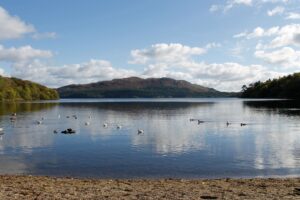
Knocknarea Sligo Ireland
Knocknarea is a large prominent hill west of Sligo town in County Sligo, Ireland, with a height of 327 metres. Knocknarea is visually striking as it has steep limestone cliffs and stands on the Cúil Irra peninsula overlooking the Atlantic coast. Wikipedia
WELCOME TO YEATS SOCIETY SLIGO
Celebrating the life and works of WB Yeats and his talented family.
The Yeats Building in the heart of Sligo is a hub for literary culture and the arts. We have a permanent Yeats exhibition and the Hyde Bridge Gallery on the first floor offers a range of contemporary exhibitions. In 2022, we will offer the 63rd Yeats International Summer School – the longest-running literary summer school in the world.
WB Yeats is Ireland’s greatest poet and considered by many the finest poet of the twentieth century. His father John Butler Yeats was a renowned portraitist, his sisters were innovative craftworkers and printers, and his brother Jack Yeats became Ireland’s most celebrated painter.
Sligo County Museum and Art Gallery
The Sligo County Museum contains a fascinating collection of exhibits detailing Sligo’s rich stone-age history, including a large firkin of 100-year-old bog butter.
The Yeats Room here is full of manuscripts, photographs, letters and newspaper cuttings associated with the local poet William Butler Yeats including a copy of his 1923 Nobel Prize winning medal and a complete collection of his poems from 1889 to 1936.
Sligo Abbey
This Dominican friary has dominated Sligo town centre since the mid-thirteenth century, when it was created by Maurice FitzGerald, the founder of the town itself. Some of the building from that period has survived the next nine centuries of turmoil.
The abbey was partially destroyed by burning in 1414, when it fell foul of an unattended candle, and suffered further mutilation following the Rebellion of 1641. According to legend, worshippers salvaged the abbey’s silver bell at that time and threw it into Lough Gill. You can hear it peal even now – provided, that is, that you are wholly free from sin.
Grange Village, Sligo
Grange, a village on the N15 national primary road in County Sligo, Ireland. It is located between the Atlantic Ocean an The poet inspiring Benbulben, the table mountain of Ireland. Streedagh Strand, a well known surfing location with a beautiful large sandy beach is only a short distance away. At Streedagh Strand you will also find three Armada wrecks and a wonderful slat water lagoon.
A short distance to the north are the towns of Ballyshannon and Bundoran, a surfing and seaside resort which are both bypassed, and the villages of Tullaghan and Cliffoney. To the south are Drumcliff, burial place of poet and Nobel laureate W. B. Yeats, and Sligo town.
VOYA Seaweed Baths, Strandhill Sligo
“A visit to the VOYA Seaweed Baths in Strandhill will leave your skin silky soft and your mind struggling to remember exactly what “stress” is.”
ABOUT SEAWEED BATHS
The simplest and purest of our organic treatment processes, our detoxifying seaweed baths utilise the natural power of our organic hand-harvested seaweed to deeply moisturise your skin, increase circulation and promote healing.
Enniscrone Traditional Hot Seaweed Baths
A seaweed bath is a natural relaxing experience with numerous therapeutic benefits due to its high mineral content. Hot Sea Water, Seaweed and Steam Health Baths. As the name suggests, the seaweed bath is a bath full of hot sea water with seaweed added. To confine the answer to factual description is to do a great injustice to what it is. To thousands of people who enjoy a seaweed bath, this is the ultimate bathing experience. Seaweed has a high concentration of vitamins A, B, C and E and contains Iodine, which is essential for the body’s metabolism. Healthy and relaxing all at the same time.
Imagine that you are immersed in an enormous bath, luxuriating in expensive bath oils. As you relax, you experience weightlessness. You are floating in a tranquil amber tinted sea of unashamed luxury.
Drumcliffe County Sligo
Drumcliffe is a village in County Sligo, Ireland. It is 8 km (5 miles) north of Sligo town on the N15 road on a low gravel ridge between the mountain of Ben Bulben and Drumcliff bay. It is on the Drumcliff river, originally called the “Codnach”, which drains Glencar Lake. Drumcliff is the resting place of the Irish poet W. B. Yeats.
Arranmore Island Ferry Service
Arranmore Ferry is the longest-running Ferry service to Arranmore Island. From beautiful beaches and stunning coastal walks and coastal views no better place to visit this summer. 15/20 crossing time.
Arranmore Ferry has been operating a car ferry and passenger ferry service between Burtonport and Arranmore Island for over 30 years. All car ferry vessels are fully certified by the Marine Survey Office and are maintained to the highest of standards. The crossing takes just 20 minutes. Passengers can enjoy a scenic sailing as the Arranmore Ferry navigates through a number of small islands before arriving at Arranmore Island. Along the way it is common to spot seals, birds and dolphins which frequent the waters around Arranmore Island.
The Quiet Man Museum
“The Quiet Man,” John Ford’s 1952 movie starring John Wayne, Maureen O’Hara and Barry Fitzgerald (to name but a few), was set in the village of Cong. Now, with its bronze statue of Mary Kate Danaher and John Thornton, to its Quiet Man Cottage Museum, to its guided tours, the classic movie continues to bring visitors into town.
The Famine Memorial
The Famine statues, in Custom House Quay in the Dublin Docklands, were presented to the City of Dublin in 1997.
These statues commemorate the Great Famine of the mid 19th century. During the famine approximately 1 million people died and a million more emigrated from Ireland, causing the island’s population to fall by between 20% and 25%.
No event in history has had a more profound effect on Ireland and the worldwide Irish Community than that of the Great Irish Famine (1845-1849).
Powerscourt House Gardens and Waterfall
Powerscourt Estate, located in Enniskerry, County Wicklow, Ireland, is a large country estate which is noted for its house and landscaped gardens, today occupying 19 hectares.
800 Years of history at Powerscourt
The 1st Viscount Powerscourt was keen to make his mark and assert his position as one of importance in society, so he set about transforming the medieval castle at Powerscourt into a grand mansion. In 1730 he commissioned the German-born architect Richard Castle to build Powerscourt House, a 68 room mansion which was completed in 1741. The mansion was designed around the medieval castle in the style of Palladian architecture and featured baroque dome-roofed towers on either side, giving it in the words of one architectural historian, “The massive dignity of a great Italian Renaissance villa.”
The North front was adapted to present a grand entrance in the Palladian manner, while the South front faced the gardens and was initially only two storeys in height. An extra storey was added in 1787 and further major alterations were made in the late 19th century. The house contained some of the finest 18th century interiors in Ireland and was one of the country’s most beautiful mansions. In 1961, the Slazenger family purchased the Estate from the 9th Viscount Powerscourt.
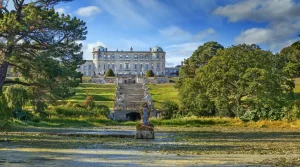
St Patrick’s Cathedral
Saint Patrick’s Cathedral in Dublin, Ireland, founded in 1191, is the national cathedral of the Church of Ireland. Christ Church Cathedral, also a Church of Ireland cathedral in Dublin, is designated as the local cathedral of the Diocese of Dublin and Glendalough.
Tayto Park
Tayto Park is an amusement park in Ireland, based on the Irish potato crisp brand Tayto. It is located in the townland of Kilbrew, in County Meath. The park first opened in November 2010.
St Mel’s Cathedral
The Cathedral Church of St Mel is the cathedral church of the Diocese of Ardagh and Clonmacnois, located in the town of Longford in Ireland. Built between 1840 and 1856, with the belfry and portico as later additions, it has been considered the “flagship cathedral” of the Irish midlands region, Longford’s “landmark building” and “one of the finest Roman Catholic churches in Ireland”. The cathedral is dedicated to Saint Mél (died 488), who came to Ireland with Saint Patrick and who was ordained bishop at Ardagh, County Longford.
On Christmas Day 2009 the cathedral was destroyed by a fire in the early hours of the morning. The restored cathedral re-opened in December 2014.
County Museum Dundalk
County Museum Dundalk is a museum located in Dundalk which documents the history of County Louth. The museum is housed in the Carroll Centre at Roden Place in Jocelyn Street, in a restored 18th century warehouse which was once part of Dundalk Distillery.
Carlingford Lough
Carlingford is a beautiful medieval coastal town situated between Dublin and Belfast, nestled between the stunning Mourne Mountains, Carlingford Lough and the Cooley Mountains.
Along the narrow medieval streets of Carlingford, you will find a wonderful array of cafes, restaurants, bars, shops, boutiques, craft workshops and antique dealers.
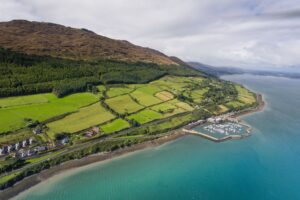
The Dingle Peninsula
The Dingle Peninsula or Corca Dhuibhne, stretches 30 miles (48 kilometres) on the south-west coast on Ireland’s Wild Atlantic Way.
A range of mountains dominates the peninsula forming its spine. It runs from Slieve Mish to Conor Pass and to Ireland’s second highest peak, Mount Brandon.
Valentia Island
Valentia island is located on the Skellig Coast in the Southern Peninsulas of the Wild Atlantic Way adjacent to the Ring of Kerry, and is still one of Ireland’s best kept secrets.
The island boasts about being the birthplace of global telecommunications, geological uniqueness stretching back 350 million years, a mix of traditional and planned built architecture, and a place where you can embrace Irish culture of language music and sport.
The Titanic Museum in Cobh
Cobh is known as the Titanic’s last port of call in 1912 and the White Star line ticket office still exists in the harbour. There is also a graveyard in Cobh that contains mass graves of victims of the Titanic. This is not all that Cobh has to offer, check out this colorful city with its “Deck of Cards” houses.
Trinity College and The Book of Kells
Trinity College was founded in 1592 by Queen Elizabeth I, and among its alumni are such renowned writers as Jonathan Swift and Oscar Wilde.
The college is visited by tourists from all over the world and the real attraction is the Old Library where you will find an amazing collection of literature. Of all the books at the Old Library, the most famous and priceless one is the “Book of Kells.” This illustrated version of the gospels was created around A.D. 800 by Celtic monks and is a must see when you get to Dublin.

Aghaboe Abbey
This fine abbey dates back to the 6th century. Its a lovely spot to take some time off. There is a big car par beside it and lots of places to sit and reflect on life. The site itself goes back to an earlier monastery that was burned in 1234.
James Joyce Centre
The James Joyce Centre is a museum in Dublin, Ireland, dedicated to promoting an understanding of the life and works of James Joyce.
The Centre is situated in a restored 18th-century Georgian townhouse at 35 North Great George’s Street, Dublin, dating from a time when north inner city Dublin was at the height of its grandeur.
Croke Park
Croke Park (Irish: Páirc an Chrócaigh) is a Gaelic games stadium located in Dublin, Ireland. Named after Archbishop Thomas Croke, it is sometimes called Croker by GAA fans and locals. It serves as both the principal stadium and headquarters of the Gaelic Athletic Association (GAA). Since 1891 the site has been used by the GAA to host Gaelic sports, including the annual All-Ireland in Gaelic football and hurling.

The National Botanic Gardens
The National Botanic Gardens (Irish: Garraithe Náisiúnta na Lus) is a botanical garden, located in Glasnevin, 5 km north-west of Dublin city centre, Ireland.The 19.5 hectares are situated between Glasnevin Cemetery and the River Tolka where it forms part of the river’s floodplain.
The old Church, Dunlewey
Nestled at the foot of Errigal (the hightest mountain in County Donegal) and overlooking the beautiful Poisoned Glen sits the beautiful ‘Old Church of Dunlewey’.
“Jane Smith Russell had the church built as a memorial to her husband, James Russell, landlord of the Dunlewey Estate, who died on 2nd September 1848. James Russell was laid to rest in a vault under the church floor. The church was consecrated on 1st September 1853 as a Chapel of Ease to Tullaghabegley. Tullaghabegley was the parish consisting of the present day Gweedore and Cloughaneely parishes.
Glasnevin Cemetery
Glasnevin Cemetery (Irish: Reilig Ghlas Naíon) is a large cemetery in Glasnevin, Dublin, Ireland which opened in 1832. It holds the graves and memorials of several notable figures, and has a museum.
The cemetery is located in Glasnevin, Dublin, in two parts. The main part, with its trademark high walls and watchtowers, is located on one side of the road from Finglas to the city centre, while the other part, “St. Paul’s,” is located across the road and beyond a green space, between two railway lines.
St Colman’s Cathedral, Cobh
The Cathedral Church of St Colman, usually known as Cobh Cathedral, or previously Queenstown Cathedral, is a single-spire cathedral in Cobh, Ireland. It is a Roman Catholic cathedral and was completed in 1919. Built on Cathedral Place, it overlooks Cork harbour from a prominent position, and is dedicated to Colmán of Cloyne, patron saint of the Diocese of Cloyne. It serves as the cathedral church of the Diocese.
Construction began in 1868 and was not completed until over half a century later due to increases in costs and revisions of the original plans. With the steeple being 91.4 metres tall (300 ft), the cathedral is the tallest church in Ireland. It was considered to be the second-tallest, behind St John’s Cathedral in Limerick which was believed to be 94 metres tall; newer measurements have shown that the St John’s spire is in fact 81 metres tall and therefore only the fourth tallest church in Ireland.
Molly Malone Statue, Dublin
“Molly Malone” (also known as “Cockles and Mussels” or “In Dublin’s Fair City“) is a popular song set in Dublin, Ireland, which has become its unofficial anthem.
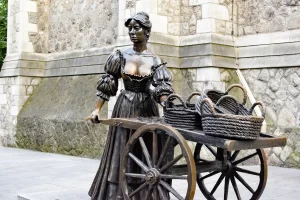
Ha’Penny Bridge, Dublin
The Ha’penny Bridge, known later for a time as the Penny Ha’penny Bridge, and officially the Liffey Bridge, is a pedestrian bridge built in May 1816 over the River Liffey in Dublin, Ireland.
Benbulbin, The Table Mountain of Ireland
Benbulbin is one of the most photographed mountains in Ireland and a must-see area for any trip to Ireland. Anyone that sees the beauty of the area will want to come back and see more. Benbulbin is also the setting of many Irish legends and folklore. It is Located in one of the most beautiful regions of Ireland, County Sligo.
Muckross House, Killarney National Park
This nineteenth century Victorian mansion is set against the stunning beauty of Killarney National Park. The house stands close to the shores of Muckross Lake, one of Killarney’s three lakes, famed world wide for their splendour and beauty. As a focal point within Killarney National Park, Muckross House is the ideal base from which to explore this landscape.
Muckross House was built for Henry Arthur Herbert and his wife, the water-colourist Mary Balfour Herbert. This was actually the fourth house that successive generations of the Herbert family had occupied at Muckross over a period of almost two hundred years. William Burn, the well-known Scottish architect, was responsible for its design. Building commenced in 1839 and was completed in 1843.
Dingle Oceanworld Aquarium
Oceanworld Aquarium is located in Dingle, County Kerry and is Ireland’s largest aquarium.
Our Aquarium hosts a collection of magnificent Sand Tiger Sharks, Gentoo Penguins , Asian Short-Clawed Otters and includes an abundance of different fish species.
Experience this enchanting underwater world and learn the wonders of the ocean.
Dublin Zoo
Dublin Zoo was opened by the Zoological Society of Ireland in 1831 on four acres of land in the Phoenix Park. The early collections included monkeys, lions, leopards, bears and parrots. In 1835, the zoo rented an elephant and a rhinoceros for the summer months. In 1836, London Zoo gave Dublin an elephant. Enclosures were rudimentary, designed for containment and to provide visitors with a good view of the animal. The iconic thatched entrance was built in 1833.

The old Jameson Distillery
The original distillery on this site was called the Bow Street Distillery and was established in 1780. John Jameson took full ownership (he was previously the general manager) and expanded the distillery in 1805. By 1810, the operation was officially renamed to John Jameson & Son’s Bow Street Distillery. The distillery grew to an upwards of 5 acres (2 ha) by 1886.
Dingle
Bring the beauty of Ireland into your front room with this immersive tour of the Dingle Peninsula. Described by National Geographic as ‘the most beautiful place on earth,’ the Dingle Peninsula is a glorious mix of untouched wilderness, stunning coastlines and beautiful little towns.
Dingle is a small port town on southwest Ireland’s Dingle Peninsula, known for its rugged scenery, trails and sandy beaches. A statue of long-time harbour resident Fungie the dolphin is by the waterfront.
Killarney National Park
When you visit Killarney National Park, make sure you don’t miss Torc Waterfall.Torc Waterfall (from Irish: Easach Toirc, meaning “cascade of the wild boar”) is a 20 metres (66 ft) high, 110 metres (360 ft) long cascade waterfall formed by the Owengarriff River as it drains from the Devil’s Punchbowl corrie lake at Mangerton Mountain. The waterfall, which lies at the base of Torc Mountain, in the Killarney National Park, is 4.3 miles (7 kilometres) from Killarney in Kerry, Ireland.
Torc Waterfall Killarney
Torc Waterfall (from Irish: Easach Toirc, meaning “cascade of the wild boar”) is a 20 metres (66 ft) high, 110 metres (360 ft) long cascade waterfall formed by the Owengarriff River as it drains from the Devil’s Punchbowl corrie lake at Mangerton Mountain. The waterfall, which lies at the base of Torc Mountain, in the Killarney National Park, is 4.3 miles (7 kilometres) from Killarney in Kerry, Ireland.
The waterfall is a popular site on the Ring of Kerry and the Kerry Way tours. The word Torc is from the Irish translation of a “wild boar”, and the area is associated with legends involving wild boars. One legend is of a man who was cursed by the Devil to spend each night transformed into a wild boar, but when his secret was revealed by a local farmer, he burst into flames and disappeared into the nearby Devils Punchbowl on Mangerton Mountain from which the Owengarriff River emerged to hide the entrance to his cave beneath the Torc Waterfall.
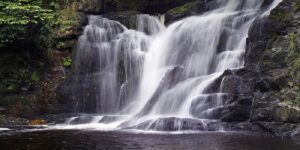
Skellig Michael
Skellig Michael (Irish: Sceilg Mhichíl) (or Great Skellig; Irish: Sceilig Mhór) is a twin-pinnacled crag 11.6 kilometres (7.2 mi) west of the Iveragh Peninsula in County Kerry, Ireland. The island is named after the archangel Michael, while the word “Skellig” is derived from the Gaelic sceilig, meaning a splinter of stone. Its twin island, Little Skellig (Sceilig Bheag), is smaller and inaccessible.
The two islands rose c. 374-360 million years ago during a period of mountain formation, when they broke away from the MacGillycuddy’s Reeks land mass.
Adare Village Park
In the heart of the village is a pretty oasis and gathering place in the shape of a public park. The land for this beautiful park, like most of the village, was once part of the massive Dunraven estate. One feature of the park is the lovely thatched gazebo, which plays a part in village events and is a popular photographic background for the many weddings that take place in Adare all year round.
Adare is a village in County Limerick, Ireland, located south-west of the city of Limerick. Renowned as one of Ireland’s prettiest towns, Adare is designated as a heritage town by the Irish government. The River Maigue is tidal as far as Adare, with the settlement forming around the eastern bank of the Maigue overlooking the fording point from which the village gets its name. An annalistic reference is made in the medieval Annals of Inisfallen at AI982.4 “The Tree of Mag Adar was broken by Leth Cuinn”.

Buttevant Friary County Cork
According to the tradition of the Observant Franciscans the proto-friary of the Irish Province of the Order, dedicated to St. Nicholas, was founded at Youghal by Maurice Fitz Gerald in 1224. The Irish Province of the Franciscans was formally erected at the general chapter of Assisi in 1230. The same chapter also appointed Richard of Ingworth as first minister provincial who appears to have taken up residence in Youghal.
Bleach Lough County Limerick
This 55 acre spring water lake is located near Dromore Castle, just outside Pallaskenry, County Limerick. It is managed by the Bleach Lough Anglers and is frequently stocked with rainbow and brown trout.
Anglers can access the lake via the shore or by use of a boat. The Club serves members from local communities, as well as visitors from all over Ireland and Europe.
St Stephen’s Green Dublin
St Stephen’s Green (Irish: Faiche Stiabhna) is a city centre public park in Dublin, Ireland. The current landscape of the park was designed by William Sheppard. It was officially re-opened to the public on Tuesday, 27 July 1880 by Lord Ardilaun.The park is adjacent to one of Dublin’s main shopping streets, Grafton Street, and to a shopping centre named for it, while on its surrounding streets are the offices of a number of public bodies as well as a stop on one of Dublin’s Luas tram lines.
Glenariff Forest Park And Waterfalls County Antrim, Northern Ireland
Glenariff Forest Park is an 1185 hectare (2928 acre) forest in County Antrim, Northern Ireland. It is part of Glenariff glen itself. The forest is managed by the Northern Ireland Forest Service, the state body responsible for forestry in the province, which is part of the Department of Agriculture, Environment and Rural Affairs.
Dunquin Harbour County Kerry
Dunquin, meaning “Caon’s stronghold”, is a Gaeltacht village in west County Kerry, Ireland. Dunquin lies at the most westerly tip of the Dingle Peninsula, overlooking the Blasket Islands. it is the most westerly settlement of Ireland.
Nearby Dunmore Head is the most westerly point of mainland Ireland. There is dramatic cliff scenery, with a view of the Blasket Islands, where Peig Sayers lived. A museum in the village tells the story of the Blaskets and the lives of the people who lived there including the well-known writers of the island, which includes Sayers, Tomás Ó Criomhthain, and Muiris Ó Súilleabháin.
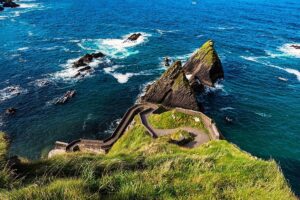
Dunluce Castle, County Antrim, Northern Ireland
In the 13th century, Richard Óg de Burgh, 2nd Earl of Ulster, built the first castle at Dunluce.
It is first documented in the hands of the McQuillan family in 1513. The earliest features of the castle are two large drum towers about 9 metres (30 ft) in diameter on the eastern side, both relics of a stronghold built here by the McQuillans after they became lords of the Route. The McQuillans were the Lords of Route from the late 13th century until they were displaced by the MacDonnell after losing two major battles against them during the mid- and late-16th century.
The Rock of Cashel
The Rock of Cashel(Irish: Carraig Phádraig), also known as Cashel of the Kings and St. Patrick’s Rock, is a historic site located at Cashel, County Tipperary, Ireland.
According to local legends, the Rock of Cashel originated in the Devil’s Bit, a mountain 20 miles (30 km) north of Cashel when St. Patrick banished Satan from a cave, resulting in the Rock’s landing in Cashel. Cashel is reputed to be the site of the conversion of the King of Munster by St. Patrick in the 5th century.
The Rock of Cashel was the traditional seat of the kings of Munster for several hundred years prior to the Norman invasion. In 1101, the King of Munster, Muirchertach Ua Briain, donated his fortress on the Rock to the Church. The picturesque complex has a character of its own and is one of the most remarkable collections of Celtic art and medieval architecture to be found anywhere in Europe.
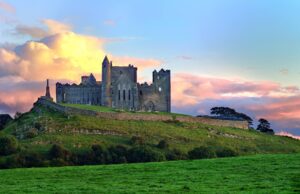
Guinness Storehouse
Guinness Storehouse is a tourist attraction at St. James’s Gate Brewery in Dublin, Ireland.Since opening in 2000, it has received over twenty million visitors.
The Storehouse covers seven floors surrounding a glass atrium shaped in the form of a pint of Guinness. The ground floor introduces the beer’s four ingredients (water, barley, hops and yeast), and the brewery’s founder, Arthur Guinness. Other floors feature the history of Guinness advertising and include an interactive exhibit on responsible drinking. The seventh floor houses the Gravity Bar with views of Dublin and where visitors may drink a pint of Guinness included in the price of admission.
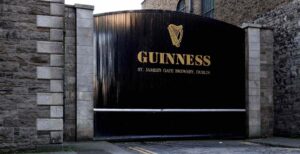
Cliffs of Moher, County Clare
The Cliffs of Moher are sea cliffs located at the southwestern edge of the Burren region in County Clare, Ireland.
They run for about 14 kilometres (9 miles). At their southern end, they rise 120 metres (390 ft) above the Atlantic Ocean at Hag’s Head, and, 8 kilometres (5 miles) to the north, they reach their maximum height of 214 metres (702 ft) just north of O’Brien’s Tower, a round stone tower near the midpoint of the cliffs, built in 1835 by Sir Cornelius O’Brien, then continue at lower heights.


